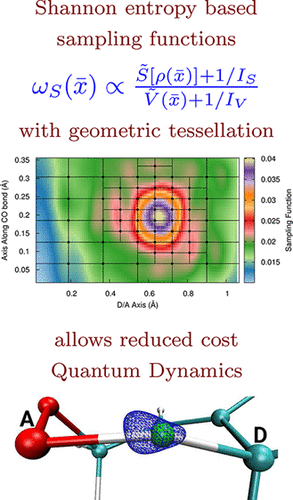当前位置:
X-MOL 学术
›
J. Chem. Theory Comput.
›
论文详情
Our official English website, www.x-mol.net, welcomes your
feedback! (Note: you will need to create a separate account there.)
Efficient and Adaptive Methods for Computing Accurate Potential Surfaces for Quantum Nuclear Effects: Applications to Hydrogen-Transfer Reactions
Journal of Chemical Theory and Computation ( IF 5.7 ) Pub Date : 2017-12-19 00:00:00 , DOI: 10.1021/acs.jctc.7b00927 Nicole DeGregorio 1 , Srinivasan S. Iyengar 1
Journal of Chemical Theory and Computation ( IF 5.7 ) Pub Date : 2017-12-19 00:00:00 , DOI: 10.1021/acs.jctc.7b00927 Nicole DeGregorio 1 , Srinivasan S. Iyengar 1
Affiliation

|
We present two sampling measures to gauge critical regions of potential energy surfaces. These sampling measures employ (a) the instantaneous quantum wavepacket density, an approximation to the (b) potential surface, its (c) gradients, and (d) a Shannon information theory based expression that estimates the local entropy associated with the quantum wavepacket. These four criteria together enable a directed sampling of potential surfaces that appears to correctly describe the local oscillation frequencies, or the local Nyquist frequency, of a potential surface. The sampling functions are then utilized to derive a tessellation scheme that discretizes the multidimensional space to enable efficient sampling of potential surfaces. The sampled potential surface is then combined with four different interpolation procedures, namely, (a) local Hermite curve interpolation, (b) low-pass filtered Lagrange interpolation, (c) the monomial symmetrization approximation (MSA) developed by Bowman and co-workers, and (d) a modified Shepard algorithm. The sampling procedure and the fitting schemes are used to compute (a) potential surfaces in highly anharmonic hydrogen-bonded systems and (b) study hydrogen-transfer reactions in biogenic volatile organic compounds (isoprene) where the transferring hydrogen atom is found to demonstrate critical quantum nuclear effects. In the case of isoprene, the algorithm discussed here is used to derive multidimensional potential surfaces along a hydrogen-transfer reaction path to gauge the effect of quantum-nuclear degrees of freedom on the hydrogen-transfer process. Based on the decreased computational effort, facilitated by the optimal sampling of the potential surfaces through the use of sampling functions discussed here, and the accuracy of the associated potential surfaces, we believe the method will find great utility in the study of quantum nuclear dynamics problems, of which application to hydrogen-transfer reactions and hydrogen-bonded systems is demonstrated here.
中文翻译:

计算量子核效应的精确势能面的高效和自适应方法:在氢转移反应中的应用
我们提出了两种采样方法来衡量势能面的关键区域。这些采样措施采用(a)瞬时量子波包密度,(b)势面的近似值,(c)梯度和(d)基于Shannon信息论的表达式,该表达式估计与量子波包相关的局部熵。这四个标准共同实现了对潜在表面的定向采样,该采样似乎正确地描述了潜在表面的局部振荡频率或局部奈奎斯特频率。然后,利用采样函数来导出细分方案,该方案可将多维空间离散化,以实现对潜在表面的有效采样。然后将采样的潜在表面与四个不同的插值过程组合在一起,即 (a)局部Hermite曲线插值;(b)低通滤波的Lagrange插值;(c)Bowman和同事开发的单项对称近似(MSA);以及(d)改良的Shepard算法。采样程序和拟合方案用于计算(a)高度非谐氢键系统中的潜在表面,以及(b)研究生物源性挥发性有机化合物(异戊二烯)中的氢转移反应,发现其中转移的氢原子表现出关键性量子核效应。在异戊二烯的情况下,此处讨论的算法用于沿氢转移反应路径推导多维势能面,以测量量子核自由度对氢转移过程的影响。基于减少的计算量,
更新日期:2017-12-19
中文翻译:

计算量子核效应的精确势能面的高效和自适应方法:在氢转移反应中的应用
我们提出了两种采样方法来衡量势能面的关键区域。这些采样措施采用(a)瞬时量子波包密度,(b)势面的近似值,(c)梯度和(d)基于Shannon信息论的表达式,该表达式估计与量子波包相关的局部熵。这四个标准共同实现了对潜在表面的定向采样,该采样似乎正确地描述了潜在表面的局部振荡频率或局部奈奎斯特频率。然后,利用采样函数来导出细分方案,该方案可将多维空间离散化,以实现对潜在表面的有效采样。然后将采样的潜在表面与四个不同的插值过程组合在一起,即 (a)局部Hermite曲线插值;(b)低通滤波的Lagrange插值;(c)Bowman和同事开发的单项对称近似(MSA);以及(d)改良的Shepard算法。采样程序和拟合方案用于计算(a)高度非谐氢键系统中的潜在表面,以及(b)研究生物源性挥发性有机化合物(异戊二烯)中的氢转移反应,发现其中转移的氢原子表现出关键性量子核效应。在异戊二烯的情况下,此处讨论的算法用于沿氢转移反应路径推导多维势能面,以测量量子核自由度对氢转移过程的影响。基于减少的计算量,











































 京公网安备 11010802027423号
京公网安备 11010802027423号